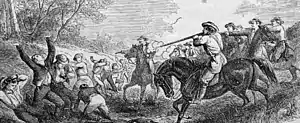
The Marais des Cygnes massacre (/ˌmɛər də ˈziːn, - ˈsiːn, ˈmɛər də ziːn/,[1][2] also /məˌriː də ˈsiːn, məˌreɪ də ˈseɪn/) is considered the last significant act of violence in Bleeding Kansas prior to the outbreak of the American Civil War. On May 19, 1858, approximately 30 men led by Charles Hamilton, a Georgia native and proslavery leader, crossed into the Kansas Territory from Missouri. They arrived at Trading Post, Kansas, in the morning and then headed back to Missouri. Along the way, they captured 11 Free-Staters, none of whom were armed and, it is said, none of whom had participated in the ongoing violence. Most of the men knew Hamilton and apparently did not realize he meant them harm. These prisoners were led into a defile, where Hamilton ordered his men to shoot, firing the first and last bullet himself. Five men were killed and five severely wounded. Only one Free-Stater escaped injury.[3]
Hamilton and his gang returned to Missouri. Only one man was ever prosecuted for his involvement in the massacre: William Griffith of Bates County, Missouri. In the spring of 1863, Griffith was recognized and arrested. That October, he was found guilty of murder and sentenced to death. Griffith was hanged on October 30, 1863.[4] Charles Hamilton returned to Georgia, where he died in 1880.
The incident horrified the U.S. and inspired John Greenleaf Whittier to write a poem on the murders, "Le Marais du Cygne", which appeared in the September 1858 The Atlantic Monthly.[5]
See also
References
- ↑ "Marais des Cygnes". The American Heritage Dictionary of the English Language (5th ed.). HarperCollins. Retrieved 4 May 2019.
- ↑ "Marais des Cygnes". Merriam-Webster.com Dictionary. Retrieved 4 May 2019.
- ↑ "Marais des Cygnes Massacre site - Kansapedia - Kansas Historical Society". www.kshs.org. Retrieved 2018-09-05.
- ↑ "William griffith". The Weekly News-Democrat. 1863-11-07. p. 2. Retrieved 2023-07-17.
- ↑ "Le Marais du Cygne". Archived from the original on 2005-12-26. Retrieved 2006-01-28.